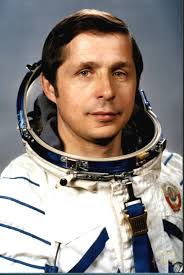Viktor Savinykh
Russian - (RFSA)
Retired
Date of Birth: March 7, 1940
Age: 85
Viktor Petrovich Savinykh was born in Berezkiny, Kirov Oblast, Russian SFSR on March 7, 1940. Married with one child. Selected as a cosmonaut on December 1, 1978. Retired on February 9, 1989. Flew as Flight Engineer on Soyuz T-4, Soyuz T-13 and Soyuz TM-5. Has spent 252 days 17 hours 38 minutes in space.
Soyuz-U | Soyuz T-4
Russian Federal Space Agency (ROSCOSMOS) | RussiaBaikonur Cosmodrome, Republic of Kazakhstan
March 12, 1981, 7 p.m.
Status: Success
Mission:
Soyuz T-4 was the 14th mission to visit the Salyut 6 space station and carried the EO-6 expedition, which was the final long-duration crew for the station. The mission began on March 12, 1981, 19:00:11 UTC, launching Commander Vladimir Kovalyonok and Flight Engineer Viktor Savinykh into orbit. They docked with the station the next day. During their 74-day stay on the station, EO-6 crew conducted various experiments, and were visited by Soyuz 39 and Soyuz 40 crews. The mission concluded with a safe landing back on Earth on May 26, 1981, 12:37:34 UTC.
Low Earth OrbitSoyuz-U2 | Soyuz T-13
Soviet Space Program | RussiaBaikonur Cosmodrome, Republic of Kazakhstan
June 6, 1985, 6:39 a.m.
Status: Success
Mission:
Soyuz T-13 was the eighth mission to visit the Salyut 7 space station. The mission began on June 6, 1985, 06:39:52 UTC, launching Commander Vladimir Dzhanibekov and Flight Engineer Viktor Savinykh into orbit. Following a two day solo flight Soyuz T-13 docked with Salyut 7 on June 08. When arriving there, the station had been vacant since eight month and it had been crippled by a solar array problem. Soyuz T-13 was the first Soyuz to dock manually with an inert Salyut. During their stay on the station, crew had to perform numerous repairs to restore life support, power and other systems, and conducted two EVAs for the same reasons. Cosmonauts were visited by a Progress cargo spacecraft and a Soyuz T-14, who joined the work on the station. Vladimir Dzhanibekov returned to Earth with the Soyuz T-14 crew member, while Viktor Savinykh stayed to continue his work on the station. The mission concluded with a safe landing back on Earth on September 26, 1985, 09:51:58 UTC.
Low Earth OrbitSoyuz-U2 | Soyuz T-14
Soviet Space Program | RussiaBaikonur Cosmodrome, Republic of Kazakhstan
Sept. 17, 1985, 12:38 p.m.
Status: Success
Mission:
Soyuz T-14 was the ninth mission to visit the Salyut 7 space station. The mission began on September 17, 1985, 12:38:52 UTC, launching Commander Vladimir Vasyutin, Flight Engineer Georgi Grechko and Research Cosmonaut Alexander Volkov into orbit. They docked with the station next day. During their stay on the station, cosmonauts assisted resident Soyuz T-13 crew with numerous repairs on the station. They also conducted some scientific experiments. Georgi Grechko returned to Earth early with the Soyuz T-13 crew member. The mission concluded with a safe landing back on Earth on November 21, 1985, 10:31:00 UTC.
Low Earth OrbitSoyuz-U2 | Soyuz TM-4
Soviet Space Program | RussiaBaikonur Cosmodrome, Republic of Kazakhstan
Dec. 21, 1987, 11:18 a.m.
Status: Success
Mission:
Soyuz TM-4 was the fourth mission to Mir space station. The mission began on December 21, 1987, 11:18:03 UTC, launching Commander Vladimir Titov, Flight Engineer Musa Manarov and Research Cosmonaut Anatoli Levchenko into orbit. They docked with Mir two days later. During their stay there, crew carried out over 2000 various experiments, performed two EVAs. They were visited by Soyuz TM-5 and Soyuz TM-6 crews. Vladimir Levchenko spent only a week on the station, while other two members of the crew stayed for a long duration mission. They returned on a Soyuz TM-6 spacecraft, landing safely back on Earth on December 21, 1988, 09:57:00 UTC.
Low Earth OrbitSoyuz-U2 | Soyuz TM-5
Soviet Space Program | RussiaBaikonur Cosmodrome, Republic of Kazakhstan
June 7, 1988, 2:03 p.m.
Status: Success
Mission:
Soyuz TM-5 was the fifth mission to Mir space station. The mission began on June 7, 1988, 14:03:13 UTC, launching Commander Anatoly Solovyev, Flight Engineer Viktor Savinykh and Research Cosmonaut Aleksandr Aleksandrov into orbit. They docked with Mir two days later, meeting with the long-duration resident crew. During their 7-day stay there, cosmonauts carried out scientific experiments. They returned on a Soyuz TM-4 spacecraft, landing safely back on Earth on June 17, 1988, 10:12:32 UTC.
Low Earth OrbitThe Roscosmos State Corporation for Space Activities, commonly known as Roscosmos, is the governmental body responsible for the space science program of the Russian Federation and general aerospace research. Soyuz has many launch locations the Russian sites are Baikonur, Plesetsk and Vostochny however Ariane also purchases the vehicle and launches it from French Guiana.
Long March 3B/E
Fengyun-4C
Launch Complex 2 (LC-2) - Xichang Satellite Launch Center, People's Republic of ChinaChina's geostationary meteorological satellite program FY-4 (Feng Yun 4) is the second generation of chinese geostationary meteorological satellites.
Long March 8A
SatNet LEO Group 17
Commercial LC-1 - Wenchang Space Launch Site, People's Republic of ChinaA batch of 9 Low Earth Orbit communication satellites for the Chinese state owned SatNet constellation operated by the China Satellite Network Group.…
Soyuz 2.1a
Obzor-R No.1
43/4 (43R) - Plesetsk Cosmodrome, Russian FederationNote: Assignment of payloads to this launch is uncertain. The Russian Obzor-R satellite is a planned X-band radar earth observation satellite desi…
LVM-3 (GSLV Mk III)
BlueBird Block 2 #1
Satish Dhawan Space Centre Second Launch Pad - Satish Dhawan Space Centre, IndiaAST SpaceMobile’s Block 2 BlueBird satellites are designed to deliver up to 10 times the bandwidth capacity of the BlueBird Block 1 satellites, requi…
Long March 12A
Demo Flight
Long March 12A Pad - Jiuquan Satellite Launch Center, People's Republic of ChinaFirst test launch of CASC/SAST’s Long March 12A rocket, with a dummy payload. The rocket’s 1st stage attempted to land on a landing pad about 300 km …




